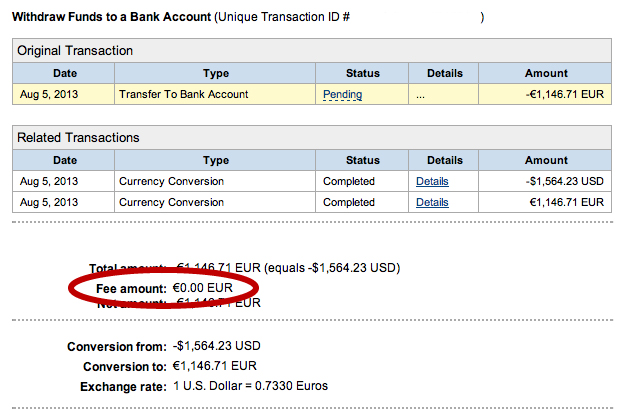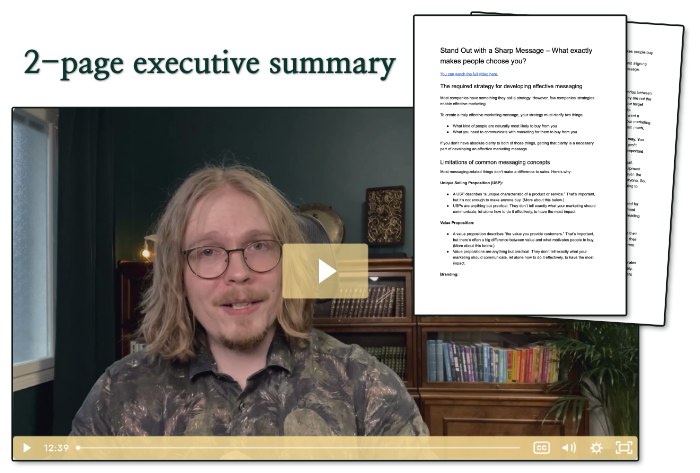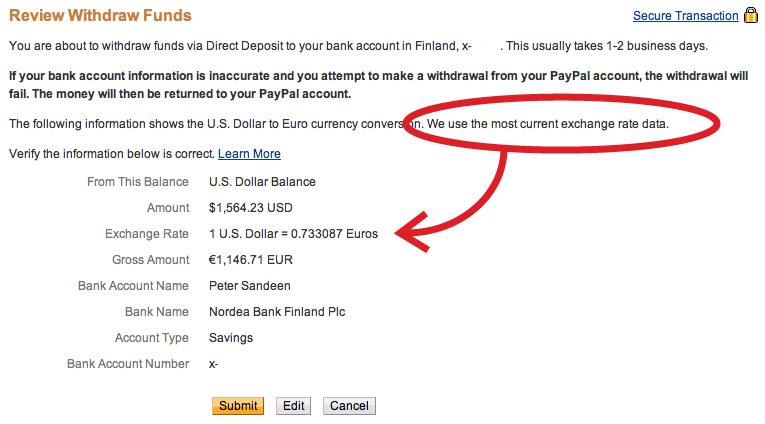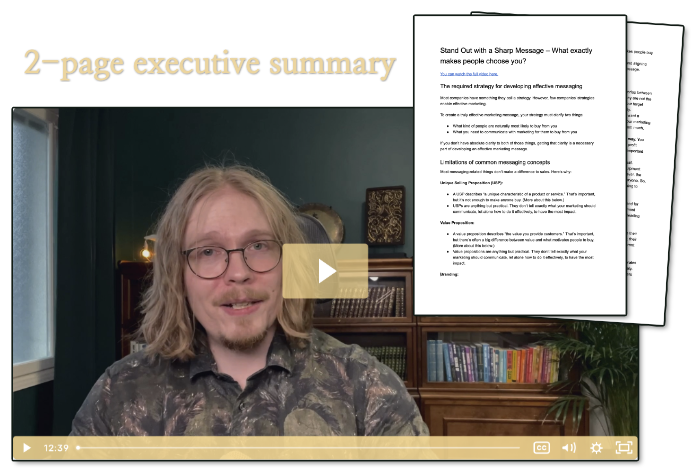NOTE: Since I published this article, PayPal has improved their withdrawal process. Now they clearly tell that they charge a currency conversion fee. However, they still don’t provide a receipt of that charge.
How I avoid paying unnecessarily for currency conversions is by routing payments to an account on Wise (formerly Transferwise), which has worked extremely well for me and many colleagues.
PayPal is used by millions. You can pay for pretty much everything from dollhouses and jumping castles to real apartments with it.
And if you run a small business, especially online, you’re going to at least consider using it to process payments because PayPal’s fees seem very reasonable.
It’s easy and free to set up. It works in most countries on this planet (I hear they’re expanding to Mars, too). And it gives you enough options to run a small business.
The transaction fees are also smaller than what you’d pay for similar services with most other companies.
But, if you look closely, and if you tally up the hidden fees, the real PayPal fees aren’t as favorable as they seem on the surface.
Simply put, PayPal steals from its customers.
Edit: PayPal has made some updates to the visuals. My point still stands, though: PayPal doesn’t provide a receipt for the charges—and that amounts to stealing (or maybe it’s “fraud” or some other legal term).
TL;DR
PayPal charges a currency conversion fee from withdrawals. That’s fine. They’re open about it (after some changes they made).
However, in the withdrawal receipt, they claim there was no fee for the withdrawal. And they block any attempt to withdraw your money in the currency it is in—as in, they force the currency conversion on you, no matter what.
Solution that I now use
I mostly use Stripe for collecting payments. And I withdraw the funds to a Wise account, which enables market rate currency conversions when you move the money to your own bank.
Transferwise does charge a small withdrawal fee, but it’s far smaller than PayPal’s currency conversion fee.
For me, this setup saves thousands every year.
Now, let’s get back to the article.
“Free” just means they don’t tell you how much they’re stealing
Transferring money to your personal or business bank account by withdrawing from your PayPal account should be free—at least it’s marked as “free” everywhere you’re likely to look.
Note that since I live in Finland, some of the screenshots might look slightly different from what you’ll find.

PayPal’s “fees” page

PayPal’s “withdrawal fees” page
Even when you click “withdraw” in your PayPal dashboard to make a withdrawal, the screen tells you it’s “free.”

PayPal’s withdrawal page
The information states that “additional bank fees may apply,” but that refers to fees imposed by your own bank. PayPal is clear that “withdrawing from your PayPal balance to your bank account” is free on their side.
But that’s a lie.
“Latest exchange rate” and other fairytales
When you make a withdrawal from one currency to another (in this example from USD to EUR), PayPal uses “the most current exchange rate” to make the conversion.
Or so they say.
This also applies if your customers pay with a currency other than your primary currency.
At the time of the withdrawal in the screenshot above, the actual exchange rate was 0.7551 rather than the stated 0.7331 (according to Google, Bloomberg, and Yahoo Finance). The difference, 2.5%, might seem small, but it adds up quickly.
I can understand the difference if they were just a little late with the exchange (a few hours maybe), since rates can fluctuate rapidly. But the exchange rate hasn’t been so low as PayPal claims in six months.
So much for “most current exchange rates.”
I make withdrawals almost every day, so I never lose too much with one withdrawal. But still, even from just this one withdrawal, PayPal stole 34.44€/$45.62.
At the time of this writing, that adds up to $5.000–$10.000 a year depending on how many of my transactions go through PayPal.
So, what does PayPal say to this?
“The total cost through PayPal [for currency conversion] is usually less than many international multi-currency bank transfers.”
A “currency conversion fee?”
If you dig deep enough, you’ll find a mention of it. But I’ll bet very few PayPal users ever notice it because it’s buried in the 23,000-word legalese-laden user agreement.
But okay, it’s there, and when I set up my PayPal account, maybe I ticked the box indicating I accepted the agreement. Or maybe it was ticked for me, and I didn’t notice.
However, standard business practice includes providing a receipt of fees charged for services rendered—even if the business tries to hide the charge.
If there’s no receipt, it didn’t happen. Right?
You’d think PayPal would provide a receipt for the fees they charge. Or at least note them somewhere in your account, so you can calculate those fees in your expenses or provide them to your accountant.
Nope.
After 14 emails and a phone call, a PayPal service rep told me, “We don’t provide receipts or anything else you could use in accounting for those charges. We also won’t provide them to you separately.”
They did, however, offer to create an Excel sheet for me that calculates the amount of the fee. As if I can’t calculate 2.5% of the sum or compare the real exchange rate to the one they use.
And they take this one step further.

Receipt of a Withdrawal made from PayPal
You actually do get a receipt when you make a withdrawal.
Here you can see that the fee for the withdrawal is 0€ (which equals $0 no matter the exchange rate).
Maybe you’d then hope that the receipts for the currency conversion would specify the fee. They even give you two of those—efficient aren’t they?
Not a chance.
There’s no way you can deduct those currency conversion charges in your bookkeeping.
And because of that, PayPal is literally stealing from everyone who uses their services when currency conversion is involved.
It’s nice that they called to apologize.
But let’s face it: they called to apologize for stealing from me and told me they’ll keep doing it.
And as a solution, they offered to help me calculate just how much they’re going to steal.
As far as repenting goes, that’s not too convincing. I’d be more likely to trust a drunk proclaiming he’s got the solution for world peace than PayPal doing something about this problem in any timely manner.
A simple solution PayPal blocks
PayPal has blocked the way to bypass the currency conversion fee—even when there’s absolutely no reason to make a currency conversion.
My idea was to open a currency account in your bank for each currency you handle through PayPal and withdraw the funds to those currency accounts without a conversion.
You’d still pay your bank for currency conversion (I would’ve paid 1.9€ per withdrawal, which is peanuts compared to how much PayPal is stealing from me).
But PayPal has blocked this option.
I checked that the idea works with my bank and PayPal. Both clearly stated there’s no problem, and I have that on writing.
But when I tried to do it, I got an error message from PayPal. And after some more emails, they informed me that they just won’t send USD to Scandinavia.
That’s exactly what I first had asked them to confirm. Twice.
One of the basic features of PayPal is the ability to accept and move any currency you want all around the world. But when it would stop them from stealing from you, it’s blocked.
It’s not that they couldn’t do it. Obviously they could—it’s their business to move money around the planet.
They just rather steal from their customers. And they’ll keep doing it until someone makes big-enough waves about it and the mainstream media notices. So far, no luck.
The solution I now use
I still have to use PayPal a little bit. But how I now save thousands every year, is by handling most of the charges through Stripe and—here’s the key thing—sending the USD to a Wise account.
Transferwise lets you set up virtual currency bank accounts. When you withdraw your money from those accounts to you normal bank, you get market rate currency conversion. They only charge a small fee for the withdrawal.
I save thousands every year with this. I’ve heard from several colleagues who do the same thing. None of us has ever had an issue with Wise, so it’s very easy to recommend them.
I don’t usually write about the financial side of business.
But I know many of my clients use PayPal and are probably facing the same situation that I have dealt with. So, this exception seemed to be in order.
If you know someone who uses PayPal, let them know about this. They might be losing thousands every year.
And if you’re building a business, take a look at this 5-step system that helps you figure out what makes people pay attention to you, join your email list, and ultimately buy your products or hire you.
Common comments and questions about this article…
Apparently many people don’t bother to read the article before commenting, so here are answers to the most common comments like that:
- “You can tell PayPal to charge you in the original currency…” This has nothing to do with the topic of this article. This article is about withdrawing money to your own bank account from PayPal.
- “They have the right to charge a currency conversion fee…” Yes, of course. I’m not disputing that. But they should not hide it—and they should give you a receipt of such a charge.
- “They don’t charge for the conversion, they just use their own conversion rate…” That’s not true. They do mention the charge if you read deep into the agreements.
- “Everyone charges for currency conversion…” Yet again, that’s not my issue. My issue is the lack of a receipt for the charge.
- “eBay…” This article has nothing to do with eBay.
- “How do you avoid the extra charges?” Read the section above.



